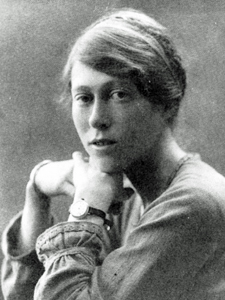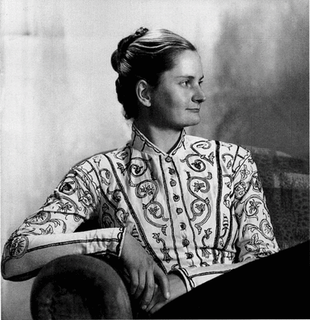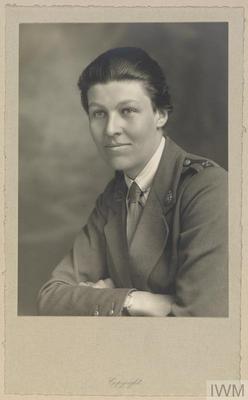
Christopher Richard Wynne Nevinson was an English figure and landscape painter, etcher and lithographer, who was one of the most famous war artists of World War I. He is often referred to by his initials C. R. W. Nevinson, and was also known as Richard.

The First Aid Nursing Yeomanry (Princess Royal's Volunteer Corps) (FANY (PRVC)) is a British independent all-female registered charity formed in 1907 and active in both nursing and intelligence work during the World Wars. Its members wear a military-style uniform, but it is not part of the Regular Army or Army Reserve; members do not train at Sandhurst, nor do they hold a commission.

Paul Nash was a British surrealist painter and war artist, as well as a photographer, writer and designer of applied art. Nash was among the most important landscape artists of the first half of the twentieth century. He played a key role in the development of Modernism in English art.

Helen Saunders was an English painter associated with the Vorticist movement.
Emily Murray Paterson RSW SWA (1855–1934) was a Scottish artist, connected with the Glasgow School and member of the Society of Women Artists.

Norah Neilson Gray was a Scottish artist of the Glasgow School. She first exhibited at the Royal Academy while still a student and then showed works regularly at the Paris Salon and with the Royal Academy of Scotland. She was a member of The Glasgow Girls whose paintings were exhibited in Kirkcudbright during July and August 2010.

Pegaret Anthony née Keeling was an English artist and lecturer in Historical Costume and Theatre History, best known for her watercolour paintings of war workers during the Second World War.
The War Artists' Advisory Committee (WAAC), was a British government agency established within the Ministry of Information at the outbreak of the Second World War in 1939 and headed by Sir Kenneth Clark. Its aim was to compile a comprehensive artistic record of Britain throughout the war. This was achieved both by appointing official war artists, on full-time or temporary contracts and by acquiring artworks from other artists. When the committee was dissolved in December 1945 its collection consisted of 5,570 works of art produced by over four hundred artists. This collection was then distributed to museums and institutions in Britain and around the world, with over half of the collection, some 3,000 works, going to the Imperial War Museum.
Eleanor Hudson, known professionally as Erlund Hudson,, was a British artist. Hudson was a watercolourist, etcher and designer and is notable for her depictions of women at work during the Second World War and for her post-war paintings of ballet dancers.
Frances Macdonald, was an English painter known for her panoramic scenes painted in Wales, the south of France and in London during World War II.
Victorine Anne Foot was a British artist who worked in oils, watercolours and pastels. Foot is best known for her work during World War II on military camouflage and for her post-war career as an artist and teacher in Scotland.

Mary Potter, OBE was an English painter whose best-known work uses a restrained palette of subtle colours.

Muriel Thompson was a decorated Scottish World War I ambulance driver, racing driver and suffragist.
Raymond James Coxon was a British artist. He enrolled at the Leeds School of Art, the Royal College of Art, and became a teacher in the Richmond School of Art. The creative work of his long and successful career—singly and in various art groups—included landscape and portrait painting, abstract works, creating church murals and serving as a war artist during World War II. In particular he was known for the bold style of his figure and portrait work. After World War Two his paintings became more abstract.
Dorothy Josephine Coke was an English artist notable for her work as a war artist on the British home front during the Second World War. Coke was also an art teacher and as an artist was known for her watercolours, which have a very free, open-air quality to them.
Catherine Dawson Giles (1878-1955) was a British modernist watercolour painter.
Victoria Monkhouse (1883–1970) was a British artist and illustrator, notable for her depictions of women working on the British Home Front during the First World War.

Beatrice Ethel Lithiby OBE was a British artist known as a painter and designer of stained glass and church furnishings. She served in both World War I and World War II in the British Army and in the former conflict also worked as a war artist for the Imperial War Museum.

(Antonia) Marian Gamwell OBE was a United Kingdom volunteer ambulance driver and commanding officer of the First Aid Nursing Yeomanry (FANY). She served with her sister Hope Gamwell during World War I and they then ran a farm in what is now Zambia. They both became pilots. They returned to the UK for World War Two and Marian commanded the FANYs after a row with the ATS. After the war they returned to Zambia before retiring to Jersey.
Elsie Gledstanes (1891–1982) was a British artist notable as a painter of portraits, figure groups and landscapes.










